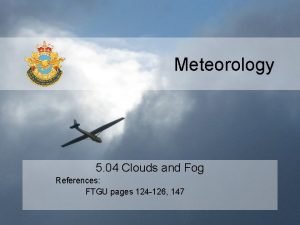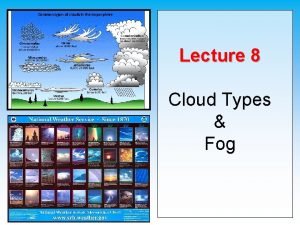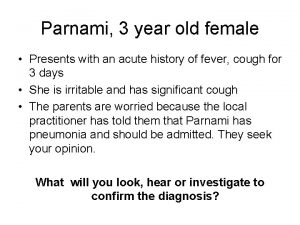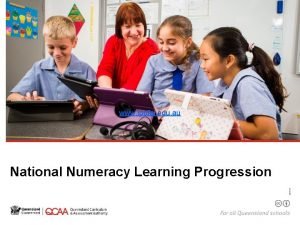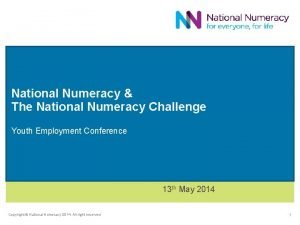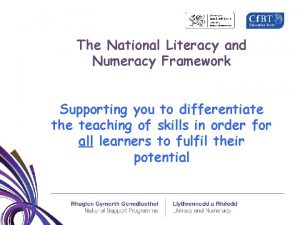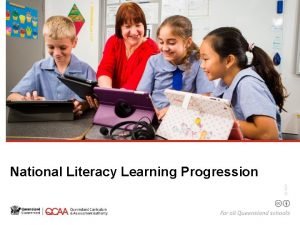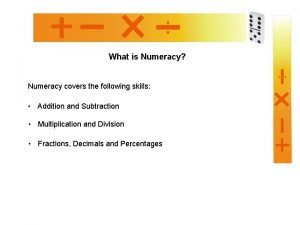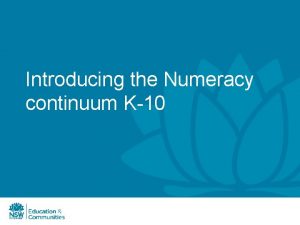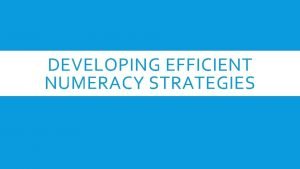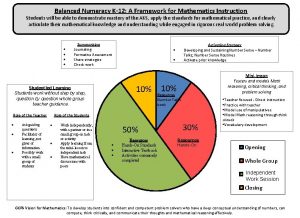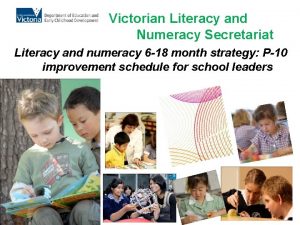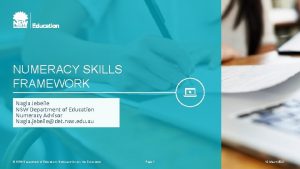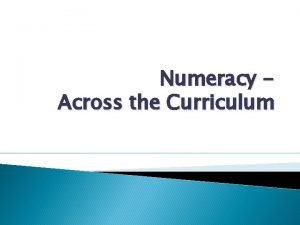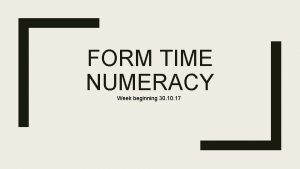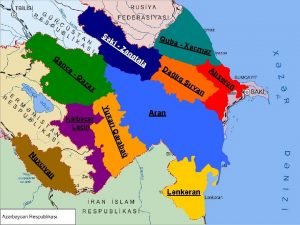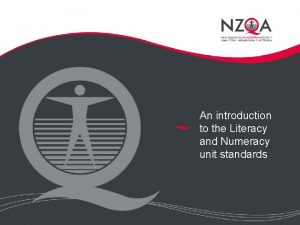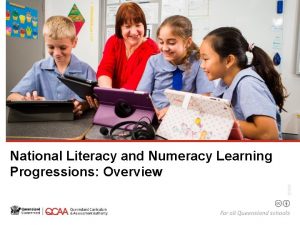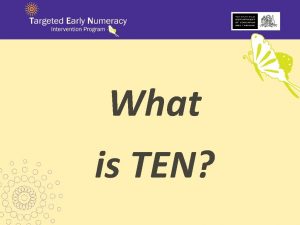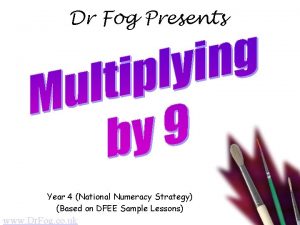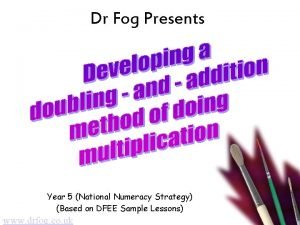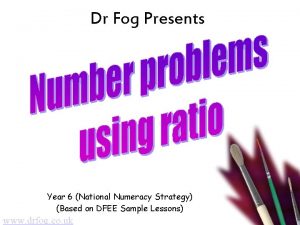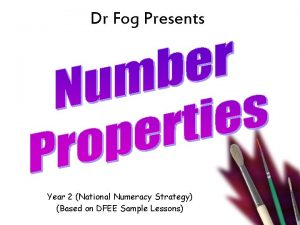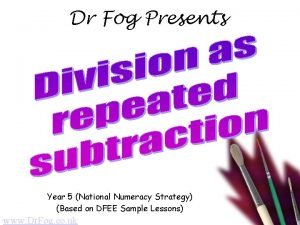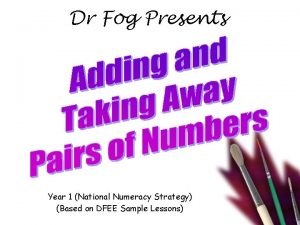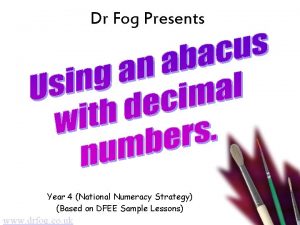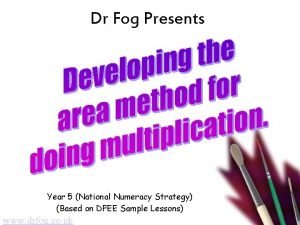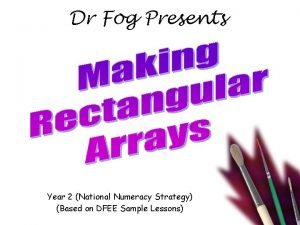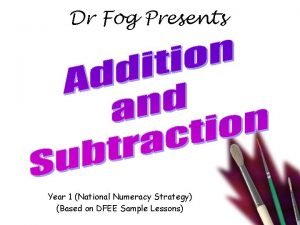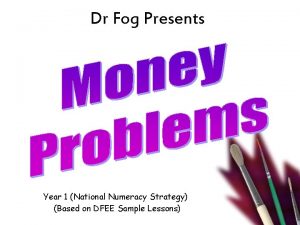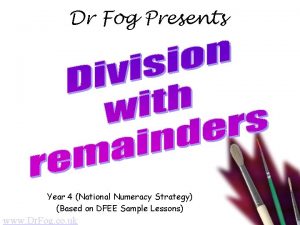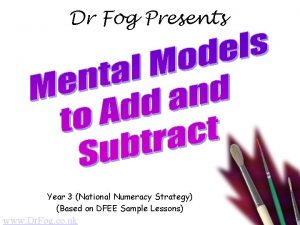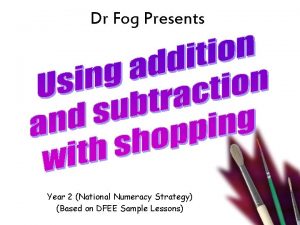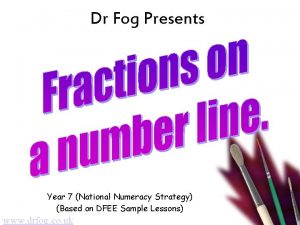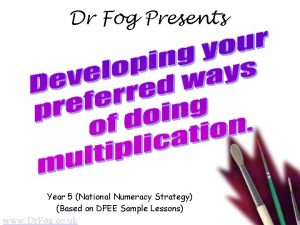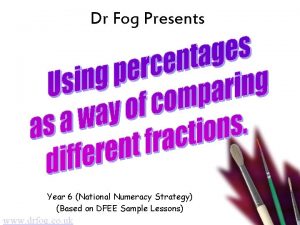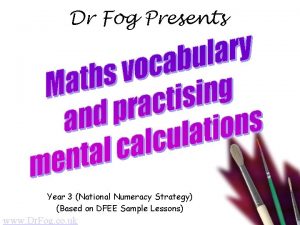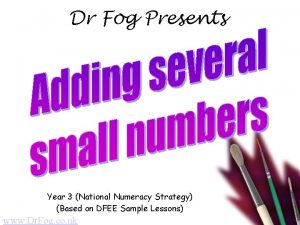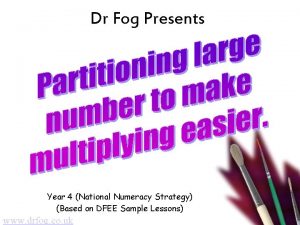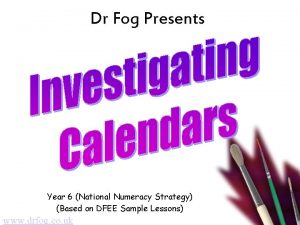Dr Fog Presents Year 6 National Numeracy Strategy
























- Slides: 24

Dr Fog Presents Year 6 (National Numeracy Strategy) (Based on DFEE Sample Lessons) www. Dr. Fog. co. uk

Resources • Calculators (Optional)

Mental Learning Objective • Use known number facts and place value to consolidate mental multiplication and division facts.

Mental Learning Task • Today we are going to spend a few minutes exploring methods for mental multiplication.

Mental Learning Task • Get into pairs. • Pick two numbers off the board and discuss how you would multiply them. 13 12 25 49 45 21 30 54

Mental Learning Task • What numbers could you multiply together in your head? 13 12 25 49 45 21 30 54

Mental Learning Task • What numbers would you need to use pencil and paper for? 13 12 25 49 45 21 30 54

Mental Learning Objective • Use known number facts and place value to consolidate mental multiplication and division facts.

Main Learning Objective • Solving mathematical puzzles. • Recognise and explain patterns and relationships, generalise and predict.

Key idea

Main Learning Task • Today we are going to start by finding products mentally. • We are also going to learn how to add a string of numbers together.

Main Learning Task • I want you to write these four numbers in any order in the cells of the square. 25 35 30 20

Main Learning Task • Now in the green squares write what the product of the number is between each neighbouring number.

Main Learning Task • Now I want you to add all the products together.

Main Learning Task • Write all the numbers in the green boxes in the white number box. + + + =

Main Learning Task • How should we do this? • What do we add first? + + + =

Main Learning Task • Work out the answer. • What is it? • Does everyone agree? + + + =

Main Learning Task • Your task is to find a way to organise the numbers so you get the largest possible total. • You must check your answers by using an inverse operation or by using different method. • When you have finished, use the number 15, and complete a 3 x 3 grid.

Main Learning Task • I want you now to find the largest possible total. Simplification Middle Challenge 30 50 20 60 48 35 45 25 75 2 6

Main Learning Objective • Solving mathematical puzzles. • Recognise and explain patterns and relationships, generalise and predict.

Plenary • We are going to use the numbers 2, 4, 6, 8. • Which arrangements give the best totals? • Should high numbers be next to high or low numbers to get the maximum sum?

Plenary • Homework: • Make a 2 x 3 grid. • Use the numbers 2, 2, 4, 4, and 6, 6 • Should high numbers be put next to high or low numbers for the biggest total.

Review of Key Idea • I can explore an idea by simplifying it and by making generalisations. • Did you learn this today?

Where Can I Find More Resources Like This? • You can now visit my teaching resource website at http: //www. Dr. Fog. co. uk • You can click here to search for more of my teaching resources. • Click here to visit my TES shop!
 Advection fog vs radiation fog
Advection fog vs radiation fog Advection fog vs radiation fog
Advection fog vs radiation fog Advection fog vs radiation fog
Advection fog vs radiation fog A 26 year old female presents
A 26 year old female presents A 41 year old man presents with slow irregular breathing
A 41 year old man presents with slow irregular breathing National literacy and numeracy learning progressions
National literacy and numeracy learning progressions National numeracy challenge
National numeracy challenge Literacy numeracy framework
Literacy numeracy framework National literacy progressions
National literacy progressions Leavers assembly poems year 6
Leavers assembly poems year 6 Numeracy stages
Numeracy stages Numeracy continuum
Numeracy continuum Facile counting
Facile counting Balanced numeracy framework
Balanced numeracy framework Literacy and numeracy secretariat
Literacy and numeracy secretariat Numeracyskills.com.au
Numeracyskills.com.au Numeracy across the curriculum audit
Numeracy across the curriculum audit Grade 10 numeracy assessment practice test
Grade 10 numeracy assessment practice test Form time numeracy
Form time numeracy Scottish survey of literacy and numeracy
Scottish survey of literacy and numeracy Aq q
Aq q Numeracy unit standards
Numeracy unit standards Literacy and numeracy progressions
Literacy and numeracy progressions Stages of early arithmetical learning
Stages of early arithmetical learning Targeted early numeracy (ten) intervention program
Targeted early numeracy (ten) intervention program
